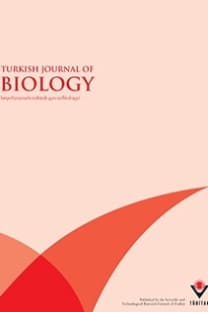Isolation and identification of lactic acid bacteria from boza, and their microbial activity against several reporter strains
Key words: Antimicrobial activity, API ZYM, boza, lactic acid bacteria, proteolytic activity, riboprinter
Isolation and identification of lactic acid bacteria from boza, and their microbial activity against several reporter strains
Key words: Antimicrobial activity, API ZYM, boza, lactic acid bacteria, proteolytic activity, riboprinter,
___
- Gotcheva V, Pandiella SS, Angelov A et al. Microfl ora identifi cation of the Bulgarian cereal-based fermented beverage boza. Process Biochemistry 36: 127-130, 2000. 2.
- Topal S, Yazıcıoglu T. A study on microfl ora of boza. Turk J Biol
- Fooks LJ, Fuller R, Gibson GR. Prebiotics, probiotics and human gut microbiology. Int Dairy J 9: 5-61, 1999. 9. Zhu WM, Liu W, Wu DQ. Isolation and characterisation of a new bacteriocin from Lactobacillus gasseri KT7. Journal of Applied Microbiology 88: 877-886, 2000.
- Schillinger U, Lücke FK. Antibacterial activity of Lactobacillus sake isolated from meat. Applied and Environmental Microbiology 55: 1901-1906, 1989.
- Demirci M, Gunduz H. Dairy technology handbook. Hasad Press. Turkey; 1994.
- Rajagopal SN, Sandine WE. Associative growth and proteolysis of Streptococcus thermophilus and Lactobacillus bulgaricus in skim milk. Journal of Dairy Science 73: 894-899, 1990.
- Patrick WA, Wagner HB. Determination of hydrogen peroxide in small concentrations. Analytical Chemistry 21: 1279-1280, 1949.
- Akinrele IA. Fermentation studies on maize during the preparation of a traditional African starch-cake food. Journal of the Science of Food and Agriculture 21: 619-625, 1970.
- Arici M, Daglioglu O. Boza: a lactic acid fermented cereal beverage as a traditional Turkish food. Food Research International 18: 39-48, 2002.
- Fricourt BV, Barefoot SF, Testin RF et al. Detection and activity of plantaricin F an antibacterial substance from Lactobacillus plantarum BF001 isolated from processed channel catfi sh. Journal of Food Protocol 57: 698-702, 1994.
- Kıvanç M. Antagonistic action of lactic cultures toward spoilage and pathogenic microorganism in food. Die Nahrung 34: 273-277, 1990.
- Aslim B, Yuksekdag Z, Sarikaya E et al. Determination of the bacteriocin-like substances produced by some lactic acid bacteria isolated from Turkish dairy products. LWT-Food Science and Technology 38: 691-694, 2005.
- Gómez R, Muñoz M, Ancos B et al. New procedure for the detection of lactic acid bacteria in vegetables producing antibacterial substances. Lebensmittel-Wissenschaft und- Technologie 35: 284-288, 2002.
- Makras L, Triantafyllou V, Fayol-Messaoudi D et al. Kinetic analysis of the antibacterial activity of probiotic lactobacilli towards Salmonella enterica serovar typhimurium reveals a role for lactic acid and other inhibitory compounds. Research in Microbiology 157: 241-247, 2006.
- Devlieghere F, Vermeiren L, Debevere J. New preservation technologies: possibilities and limitations. Rev. Int. Dairy J 14: 273-285, 2004.
- Ocando A, Granados A, Lasanta Y et al. Organic acids of low molecular weight produced by lactobacilli and enterococci isolate from Palmita type Venezuelan cheeses. Food Microbiol 10: 1-7, 1993.
- Guerra M, Fernando M, Bernardo A. Characterization of the inhibitors eff ects of L. monocytogenes Scott A, produced by ripening microfl ora of Alentejo’s traditional cheeses. Rev. Portuguesa Ciencias Veterinarias 96(538): 65-69, 2001.
- Tome E, Teixeira P, Gibbs PA. Anti-listerial inhibitory lactic acid bacteria isolated from commercial cold smoked salmon. Food Microbiology 23: 399-405, 2006.
- Piard JC, Desmazeaud M. Inhibiting factors produced by lactic and bacteria part L. oxygen metabolites and catabolism end- products. Lait 71: 525-541, 1991.
- Piard JC, Desmazeaud M. Inhibiting factors produced by lactic acid bacteria. Part Z. bacteriocins and other antibacterial substances. Lait 72: 113-142, 1992.
- Carrasco MS, Scarinci HE, Simonetta AC. Antibacterial activity of lactic acid bacteria isolated from Argentinean dairy products. Australian J of Dairy Technology 57: 15-19, 2002.
- Vignolo GM, Suriani F, Ruiz Holgado et al. Antibacterial activity of Lactobacillus strains isolated from dry fermented sausages. J App Bacterol 75:344-349, 1993.
- Ciarfardini G, Marsilio V, Lanza B et al. Hydrolysis of oleuropein by Lactobacillus plantarum strains associated with olive fermentation. Applied and Environmental Microbiology 60: 4142-4147, 1994.
- Juven BJ, Weisslow CzH, Harel S. Detection of hydrogen peroxide produced by meat lactic starter cultures. Journal of Applied Bacteriology 65: 357-360, 1988.
- Raccach M, Baker RC. Formation of hydrogen peroxide by meat starter cultures. Journal of Food Protection 41: 798-799, 1978.
- Yang R, Johnson MC, Ray B. Novel method to extract large amounts of bacteriocins from lactic acid bacteria. Applied and Environmental Microbiology 38: 3355-3359, 1992.
- Soomro A, Masud T, Anward K. Role of lactic acid bacteria (LAB) in food preservation and human health—a review. Pak Journal of Nutrition 1: 20-24, 2002.
- Law BA, Kolstad J. Proteolytic systems in lactic acid bacteria. Antonie Leeuwenhook 49: 225-227, 1983.
- Tamine AY, Deeth HC. Yoghurt: technology and biochemistry. Journal of Food Protection 43: 939-941, 1980.
- ISSN: 1300-0152
- Yayın Aralığı: 6
- Yayıncı: TÜBİTAK
Filiz SAVAROĞLU, Cansu Filik İŞÇEN, Ayşe Pınar Öztopcu VATAN, Selda KABADERE, Semra İLHAN, Ruhi UYAR
Manickam RAJA, Murugan MURALIDHARAN, Muthukumarasamy ARUNACHALAM
The protective effect of boric acid on aluminum-induced hepatotoxicity and genotoxicity in rats
Hasan TÜRKEZ, Fatime GEYİKOĞLU, Suat ÇOLAK
The analgesic effect of the ethanolic extract of Matricaria aurea
Antagonistic potential of marine Actinobacteria against fish and shellfish pathogens
Total phenolic contents and antioxidant In, Jehad AHMED, Ayşegül GÜVENÇ, Nurgün KÜÇÜKBOYACI, Ayşe BALDEMİR, Maksut COŞKUN
Merih KIVANÇ, Meral YILMAZ, Erdoğan ÇAKIR
Nurgün KÜÇÜKBOYACI, Semiha ÖZKAN, Nezaket ADIGÜZEL, Fatma TOSUN
An entomopathogenic bacterium, Pseudomonas putida, from Leptinotarsa decemlineata
Hacer MURATOĞLU, Zihni DEMİRBAĞ, Kazım SEZEN
Molecular diversity of thermophilic bacteria isolated from Pasinler hot spring (Erzurum, Turkey)
Ahmet ADIGÜZEL, Kadriye İNAN, Fikrettin ŞAHİN, Tulin ARASOĞLU, Medine GÜLLÜCE
